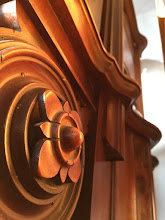
Note Kale & Brussels Sprouts on the left (transplant from generous neighbour) & Lovage in the center (in above photo). Peas and Swiss Chard are just starting to break the surface (can't see in this photo). Part of the experiment was to test the cold frame in frost conditions with a sensitive plant like tomatoes. Frost was predicted that night, so last minute scrambling resulted in blankets and tarps over the windows and a 60W bulb placed inside to provide a heat source (a method used successfully by my aunt). I had plans to put a fan inside as well to circulate the heat, but due to limitations with the extension cord and time, only the light was used in the end.
Part of the experiment was to test the cold frame in frost conditions with a sensitive plant like tomatoes. Frost was predicted that night, so last minute scrambling resulted in blankets and tarps over the windows and a 60W bulb placed inside to provide a heat source (a method used successfully by my aunt). I had plans to put a fan inside as well to circulate the heat, but due to limitations with the extension cord and time, only the light was used in the end.
 The tomatoes survived the night with a frost of about -1.4 °C according to Environment Canada measurement at the Calgary International Airport. The Middle Earth Garden is about the same elevation as the airport and within 4km or so. So the airport temperatures are likely a good approximation for now.
The tomatoes survived the night with a frost of about -1.4 °C according to Environment Canada measurement at the Calgary International Airport. The Middle Earth Garden is about the same elevation as the airport and within 4km or so. So the airport temperatures are likely a good approximation for now.A high-low recording thermometer is on the list of items to purchase for future experimentation. If anyone can recommend a thermometer please let me know. All the ones I've seen so far at Canadian Tire are battery operated digital and I'm trying to find a non-battery type. Searching just now there is one at Lee Valley. I have not been there yet as it is a bit far by bicycle. I suppose a digital thermometer with an indoor alarm for low temperature might be handy too, maybe establish trending into the computer... OK maybe too high-tech for this low-tech garden operation!




3 comments:
If the ground is warm, plastic 2 litre or 4 litre bottles with the bottoms cut out work well as mini-green houses but will likely reduce their recycle value if AB has such.
I am new veggie gardener in calgary reading your blog for the first time. Very informative! Does the California poppy come back year after year or do you re-seed? Also, I am confused about your location. Where is the Nose Creek Valley? Are you east of Nose Hill?
TBF: Great idea! Haven't tried that yet. Have you had any success with this?
Anonymous: The California Poppies come back every year, I assume they reseed themselves as I don't think they are perennial (not 100% on that). I have never seeded them in the past 3 years, they just do their own thing.
The Nose Creek valley runs east of Nose Hill parallel with Deerfoot Trail. See the following map showing creek and watershed:
http://nosecreekpartnership.com/documents/Nose%20Creek%20Basin%20Map/Nose%20Creek%20Basin%20Map.pdf
Post a Comment